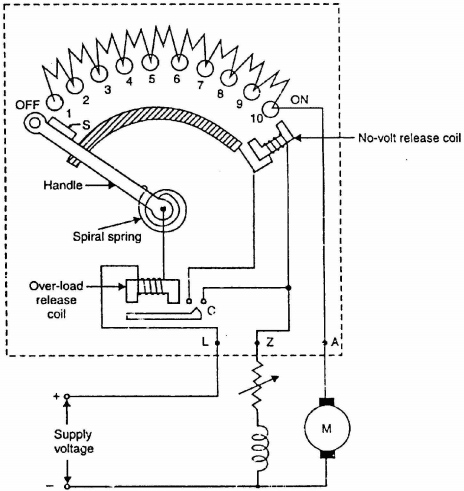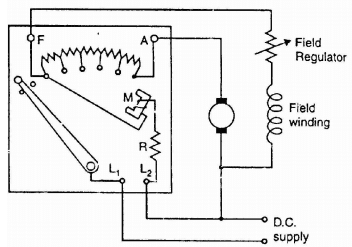Three Point Starters:
Three point starter is widely used for starting shunt and compound motors.
Three point starter Schematic Diagram:
 |
| Three point starter Schematic Diagram |
The figure shows the schematic diagram of a three-point starter for a shunt motor with protective devices.It is so called because it has three terminals L, Z and A. The starter consists of starting resistance divided into several sections and connected in series with the armature.The tapping points of the starting resistance are brought out to a number of studs. The three terminals L, Z and A of the starter are connected respectively to the positive line terminal, shunt field terminal and armature terminal. The other terminals of the armature and shunt field windings are connected to the negative terminal of the supply. The no-volt release coil is connected in the shunt field circuit. One end of the handle is connected to the terminal L through the overload release coil. The other end of the handle moves against a spiral spring and makes contact with each stud during starting operation, cutting out more and more starting resistance as it passes over each stud in clockwise direction.
Three Point Starter Operation:
(i) To start with, the d.c. supply is switched on with handle in the OFF position.
(ii) The handle is now moved clockwise to the first stud. As soon as it comes in contact with the first stud, the shunt field winding is directly connected across the supply, while the whole starting resistance is inserted in series with the armature circuit.
(iii) As the handle is gradually moved over to the final stud, the starting resistance is cut out of the armature circuit in steps. The handle is now held
magnetically by the no-volt release coil which is energised by shunt field current.
(iv) If the supply voltage is suddenly interrupted or if the field excitation is accidentally cut, the no-volt release coil is demagnetized and the handle goes back to the OFF position under the pull of the spring. If no-volt release coil were not used, then in case of failure of supply, the handle would remain on the final stud. If the supply is restored, the motor will be directly connected across the supply, resulting in an excessive armature current.
(v) If the motor is overloaded (or a fault occurs), it will draw excessive current from the supply. This current will increase the ampere-turns of the overload release coil and pull the armature C, thus short-circuiting the no- volt release coil. The no-volt coil is demagnetized and the handle is pulled to the OFF position by the spring. Thus, the motor is automatically disconnected from the supply.
Drawbacks of Three point starters:
In a three-point starter, the no-volt release coil is connected in series with the shunt field circuit so that it carries the shunt field current. While exercising speed control through field regulator, the field current may be weakened to such an extent that the no-volt release coil may not be able to keep the starter arm in the ON position. This may disconnect the motor from the supply when it is not desired. This drawback is overcome in the four point starter.
Four Point Starter Working:
In a four-point starter, the no-volt release coil is connected directly across the supply line through a protective resistance R. Figure above shows the schematic diagram of a 4-point starter for a shunt motor (over-load release coil omitted for clarity of the figure). Now the no-volt release coil circuit is independent of the shunt field circuit. Therefore, proper speed control can be exercised without affecting the operation of no- volt release coil. Note that the only difference between a three-point starter and a four-point starter is the manner in which no-volt release coil is connected. However, the working of the two starters is the same. It may be noted that the three point starter also provides protection against an open- field circuit.This protection is not provided by the four-point starter.
